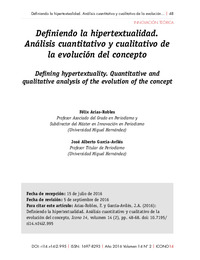Por favor, use este identificador para citar o enlazar este ítem:
https://hdl.handle.net/11000/30854Registro completo de metadatos
| Campo DC | Valor | Lengua/Idioma |
|---|---|---|
| dc.contributor.author | Arias Robles, Félix | - |
| dc.contributor.author | García-Aviles, Jose Alberto | - |
| dc.contributor.other | Departamentos de la UMH::Ciencias Sociales y Humanas | es_ES |
| dc.date.accessioned | 2024-01-31T10:17:57Z | - |
| dc.date.available | 2024-01-31T10:17:57Z | - |
| dc.date.created | 2016-07 | - |
| dc.identifier.citation | Revista ICONO14 Vol. 14 Núm. 2 (2016) | es_ES |
| dc.identifier.issn | 1697-8293 | - |
| dc.identifier.uri | https://hdl.handle.net/11000/30854 | - |
| dc.description.abstract | Pese a las múltiples referencias a la hipertextualidad, todavía existen confusiones sobre su significado. Ahora que cumple medio siglo, resulta pertinente recopilar y aclarar el significado de un término todavía esencial para entender la naturaleza de los contenidos digitales. Por eso, esta investigación realiza un análisis documental y de contenido de un conjunto de 155 referencias en 136 trabajos seleccionados a partir de una muestra inicial de 4.750. El estudio de variables como el año de publicación, el tipo de mención o los elementos presentes en las definiciones permite estudiar la evolución, desviaciones y, sobre todo, puntos en común. Este proceso pone de manifiesto la juventud de la mayoría de las referencias conceptuales, su estabilidad en el tiempo y la tendencia a la concreción. Pero, sobre todo, demuestra la necesidad de incluir en su definición elementos como estructura, contenido multimedia, interfaz digital y, especialmente, enlace y usuario. | es_ES |
| dc.description.abstract | Despite the numerous references to the concept of hypertext, there are still confusion and disagreement about its meaning. Now that it is fifty years old, it is appropriate to gather and clarify the meaning of a still essential to understanding the nature of digital content term. That is why this research is based on a document and content analysis of a set of 155 references on a corpus of 136 works selected from an initial sample of 4,750. The study of variables such as the year of publication, the type of indication or the elements in these proposals allow for study the evolution, deviations and, above all, the common ground. This process reveals the youth of most conceptual references, their stability over time and their tendency toward concreteness. But above all it demonstrates the necessity to include in their definition elements such as structure, multimedia content, digital interface and, especially, link and user. | es_ES |
| dc.format | application/pdf | es_ES |
| dc.format.extent | 21 | es_ES |
| dc.language.iso | spa | es_ES |
| dc.publisher | Asociación Cientifica ICONO 14 | es_ES |
| dc.rights | info:eu-repo/semantics/openAccess | es_ES |
| dc.rights.uri | http://creativecommons.org/licenses/by-nc-nd/4.0/ | * |
| dc.subject | Hipertextualidad | es_ES |
| dc.subject | Terminología | es_ES |
| dc.subject | Análisis documental | es_ES |
| dc.subject | Análisis de contenido | es_ES |
| dc.subject | Contenidos digitales | es_ES |
| dc.subject | Enlace | es_ES |
| dc.subject | Usuario | es_ES |
| dc.subject | Hypertextuality | es_ES |
| dc.subject | Terminology | es_ES |
| dc.subject | Document analysis | es_ES |
| dc.subject | Content analysis | es_ES |
| dc.subject | Digital content | es_ES |
| dc.subject | Link | es_ES |
| dc.subject | User | es_ES |
| dc.subject.other | CDU::0 - Generalidades.::00 - Ciencia y conocimiento. Investigación. Cultura. Humanidades. | es_ES |
| dc.title | Definiendo la hipertextualidad. Análisis cuantitativo y cualitativo de la evolución del concepto. Defining hypertextuality. Quantitative and qualitative analysis of the evolution of the concept | es_ES |
| dc.type | info:eu-repo/semantics/article | es_ES |
| dc.relation.publisherversion | https://doi.org/10.7195/ri14.v14i2.995 | es_ES |

Ver/Abrir:
2016_Definiendo la hipertextualidad. Análisis cuantitativo y cualitativo de la evolución del concepto.pdf
302,84 kB
Adobe PDF
Compartir:
 La licencia se describe como: Atribución-NonComercial-NoDerivada 4.0 Internacional.
La licencia se describe como: Atribución-NonComercial-NoDerivada 4.0 Internacional.
.png)